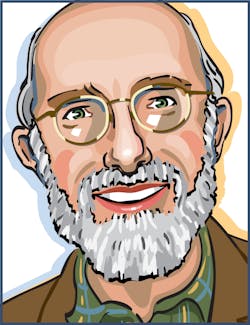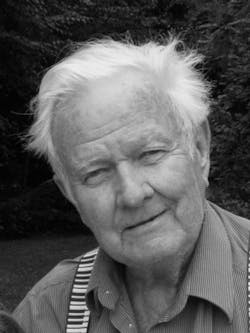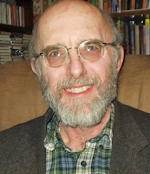Will Hicks, one of the founding fathers of fiber optics and a resident of Fiskdale, MA, died February 14, 2015, at age 91. He left his mark as a colorful and independent-minded inventor, entrepreneur, and visionary. His contributions include developing early processes to make glass-clad fibers, making the first single-mode fibers, and being among the first to realize the tremendous potential capacity of single-mode fiber communications networks.
Hicks was born in 1924 in Greenville, SC, where he was a classmate of Aurelia Townes, the younger sister of Charles Townes. After serving in the Navy, he received a master's in physics at the University of California at Berkeley, and worked briefly in South Carolina before the CIA recruited him to work at American Optical in Southbridge, MA on a CIA project to develop fiber-optic bundles to encode images for spies. Fiber optics was a new concept, so Hicks had to develop processes to clad fibers and bundle them together. The CIA application didn't work, but he later succeeded in making fiber-optic faceplates, and left American Optical to found Mosaic Fabrications, where he commercialized fused-fiber technology for military imaging systems.At Mosaic, he experimented to see how fine he could draw fibers, yielding the first single-mode fibers in 1959, which he described with Eli Snitzer, who applied waveguide theory to fibers. That laid the groundwork for later development of advanced fiber communication systems. He also tried making fiber-optic Christmas trees, an idea he abandoned after setting one alight in a hotel room after a potential customer asked if it was fireproof.
Hicks left the field after selling Mosaic in 1966, but returned several years later. He became intrigued by the prospects for single-mode fiber communications, which at the time almost everyone else thought was impractical. He calculated that wavelength-division multiplexing offered far more capacity than the gigahertz capacity envisioned a decade earlier by Charles Kao. Hicks also realized that light could be switched between fibers, and that optical amplifiers could boost signal strength, allowing long-distance transmission without optoelectronic regenerators. Thus in the late 1970s Hicks foresaw the possibility of an all-optical network, at a time when the industry was using multimode fiber at 45 megabits per second. It earned him a reputation as a wild-eyed visionary.
To develop the concept, Hicks founded a little company that he whimsically named 1984 Inc., because the future networks would have the capacity to monitor everyone. In 1982 he sold the company to Polaroid for several million dollars, but remained active both as a visionary and an entrepreneur for many years. He started six companies over his career, and his visions influenced George Gilder's projections of "infinite bandwidth" in his 2000 book Telecosm.
I got to know Hicks when I interviewed him for my book City of Light, the story of fiber optics. He was soft-spoken, rumpled, and a bit worn by the years, but he was full of ideas. He would tell stories of misadventures as well as his successes, and had an inner impishness to go with his creativity. When someone asked him how he did marketing research at a technology business meeting, he replied "I don't believe in it." Then after the laughter died down, he explained that successful entrepreneurs had to understand the market themselves.
Will Hicks is survived by his wife, Marjorie (Rice) Hicks and his children: Neil Hicks of Portland, OR; John Hicks of Eugene, OR; Louis Hicks of Lansing, NY; Robin Hicks of Sturbridge and step-son Kevin Reid-Rice of Vancouver, WA. He also leaves twelve grandchildren and one great-grandchild.
He was an authentic original, and he will be missed.


